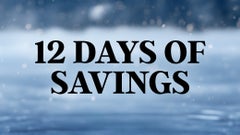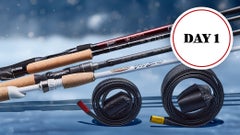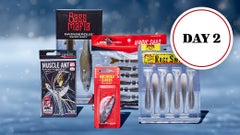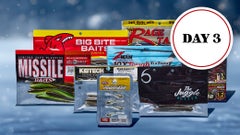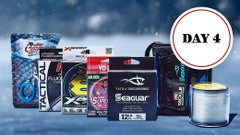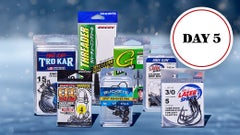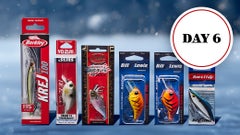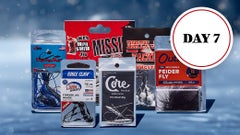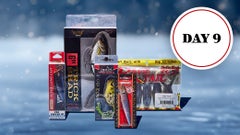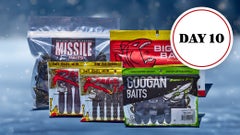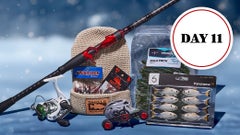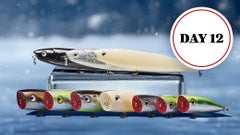FLW Lake Okeechobee Baits, Gear & Patterns
Drew Benton's Winning Pattern, Baits & Gear
Benton fished the Southeast EverStart at Okeechobee in mid January and based on his practice before that event, he figured 20 pounds a day was within reach. He busted 19-11 on day 1, but a north wind shut his area down on day 2 and managed just 6-15. "The fish were there. It was the weather just messed me up in that one," he said. Consider the lesson learned because during practice for the Tour event, he made sure to have areas that could withstand winds from virtually every direction so he wouldn't be left high and dry again. "I practiced for just about every wind," he said. "I spent some time from J&S to King's Bar and in Harney Pond all the way down the (Observation) Shoal and spent the third day on the south end. "The thing that really helped me was looking at so many areas and trying to figure out where I thought they were going to bed and where I thought they were going to move in. There were areas where I saw some beds and some males cruising around, but there wasn't anything happening during practice. During the tournament, I was able to go in there and catch them."
Competition:
Benton spent the first couple days of the event camped in South Bay as pre-spawn fish that he easily identified by their white bellies, were migrating into his area from the main lake. While he had areas up north along the Observation Shoal, the transition area was his best big-fish spot. On day 1, he plucked one 5-pounder off a bed and had two other similar fish to go with a pair of 4s as his 23-07 total helped him to open the event in 3rd place. As he push-poled around in search of new spawners, he would burn a swimbait over lily pads or cast a vibrating jig to trigger reaction strikes or catch cruisers. "Running the whole length of the shoal, I had like five or six sweet spots where I could stop and throw those baits and get bites," he said. "They might not be very big, but there were fishing moving in there and fish on beds. It's like they were bedding in little groups. You'd forever and not see any beds and then you'd get into them and there'd be four, five or six beds real close together with males on them. Every now and then you'd find one with a female." Sight-fishing helped him put 17 pounds in the boat on the morning of day 2, but quickly culled three times and was done fishing around noon. His 23-09 total pushed him to 2nd, but he was still 7 pounds back of Rick Cotten, who blasted 30-02 on Friday. The North wind on day 3 ravaged his South Bay hole, but his Plan B areas kicked out 15 pounds to push him ahead of Cotten, who came in with just three fish on Saturday.
With an east wind Sunday, he was hopeful his South Bay spot would be fishable, but he couldn't generate the same quality bites he got on days 1 and 2. "I was disappointed. I thought I would really catch them," he said. "I don't know why they didn't bite in there. The water wasn't dirty. It was just right in my opinion. The north wind was gone. You could've thrown a spinnerbait or a bladed swimjig, but they just wouldn't bite. I knew they were there. I even slowed down and tried a Texas rig, I tried to flip and I tried to go inside and see if they pulled up on beds. "They were still out there. I think when that hard wind comes in there and beats up on them, they might go back out or adjust and it might take them a couple days to get settled back down." As a result, he bounced back and forth between his shoal spots up north before finishing his day down south where a 6-pounder devoured a spinnerbait that he hadn't thrown much all week. "I had a bad practice and didn't really feel confident in what I was doing," he said. "I thought I go out there and catch fish and maybe get a check, but I didn't I'd catch anything like this."
Winning Gear:
Vibrating jig gear: 7'2" heavy-action Phenix M1 casting rod, Lew's Speed Spool casting reel (6.4:1 ratio), 20-pound Sunline Super FC Sniper fluorocarbon line, 1/2-oz. PGM vibrating jig (custom sexy shad), 3.5" Bass Assassin Die Dapper trailer (snow storm).
Sight-fishing gear: 7'6" heavy-action Phenix flipping rod, same reel, 60-pound Sunline FX2 braided line, Elite Tungsten flipping weight, 4/0 Gamakatsu Heavy Cover flipping hook, 4" Bass Assassin Pure Craw (green-pumpkin/green glitter). He also flipped with 22-pound Sunline Shooter fluorocarbon, but went with the braid when they were bedded in the real thick stuff. He didn't think color mattered much with flipping to bedding fish. "I think you could throw anything in there," he said. While scoping out beds, he picked up several keepers throwing a Bass Assassin Vapor Shad (Houdini) or a 5" Die Dapper, also in Houdini. His kicker on day 4 fell for a 3/8-oz. Hildebrandt Okeechobee Special spinnerbait (white/gold blade).
Main factor: "Trying to cover as much as water in practice and trying to find as many areas as I thought I could them on if they did move up."
Performance edge: "I really enjoy fishing out of that Phoenix boat. I was able to get back and forth to those areas pretty fast across all of that rough water. That Mercury, I'm telling you, you can run that thing through anything. Put it this way, I ran that Mercury and tried to make my own trail through the reeds and the reeds stopped the boat so I backed up and gunned it again and it kept on going. It hasn't run hot yet. That's a big deal to me and anybody who fishes grass lakes. My Power-Poles also played a big role in my sight-fishing."
Lake Okeechobee FLW Tour Winning Pattern Bassfan 2/12/13 (Todd Ceisner)
Brent Ehrler's Pattern, Baits & Gear
Flipping gear: 7'6" medium-heavy Lucky Craft casting rod, Abu Garcia Revo STX casting reel (7.3:1 ratio), 50-pound Sunline SX-1 braided line, 1/4- or 3/8-oz. Picasso tungsten flipping weight, 5/0 Gamakatsu EWG worm hook, 6" Gary Yamamoto Custom Baits Senko (black/blue flake).
Vibrating jig gear: 7'4" medium-heavy Performance Tackle casting rod, 20-pound Sunline FC Sniper fluorocarbon line, unnamed 3/8-oz. vibrating jig (black/blue), Gary Yamamoto Custom Baits Flappin' Hog trailer (black/blue). He also threw a white vibrating jig with a 3 1/2" Yamamoto Swimbait (cream white) as a trailer.
Main factor: "There wasn't any one thing in particular that I could get into as to why I did well other than having an open mind and letting the day develop. Every time I've done well in tournaments, it's when I've developed something as the tournament went on and that's how it went (last) week again."
Performance edge: "My Humminbird mapping. Those first 3 days, it was so easy to fish the outside grass lines and grass points. It's so much easier to get dialed into your waypoints and how far away from things you are. They have a thing called Casting Range on your waypoints so you know exactly how far away from your waypoint you are."
Lake Okeechobee FLW Tour 2-5 Patterns Pattern Bassfan 2/13/13 (Todd Ceisner)
Michael Neal's Pattern, Baits & Gear
Swimbait gear: 7'6" medium-heavy Nuclear Rods casting rod, Abu Garcia Revo STX casting reel (7.1:1 ratio), 80-pound PowerPro Super 8 Slick braided line, 1/8-oz. unnamed tungsten weight, 7/0 Owner hook, Gambler Big EZ (copperfield). "Everybody made fun of me for using such big line, but it worked," he said of using 80-pound braid on all of his setups.
Flipping gear: 7'6" heavy-action Nuclear Rods casting rod, same reel, same line, 1-oz. Strike King Hack Attack Heavy Cover swimjig (black/blue), Zoom Fat Albert Grub trailer (black/blue).
Vibrating jig gear: Same rod as flipping, same reel, same line, 1/2-oz. unnamed vibrating jig (golden shiner), Gary Yamamoto Swimming Senko trailer.
Main factor: "Staying in one area in practice and grinding it out and figuring out exactly what the fish were doing. If I had hopped around to different parts of the lake, especially on something this big, I would've never figured anything out."
Performance edge: "I wish I could say Power-Poles, but I don't have any. I think I'm the only person in the Top 20 that didn't have any. My Ranger Z521 and Yamaha 250 SHO gave me really good gas mileage and a smooth ride."
Lake Okeechobee FLW Tour 2-5 Patterns Pattern Bassfan 2/13/13 (Todd Ceisner)
Wade Hendrick's Pattern, Baits & Gear
Frog gear: 7'5" medium-heavy G. Loomis GLX casting rod, Shimano Curado G casting reel (7.1:1 ratio), 50-pound unnamed braided line, Spro Bronzeye frog (albino).
The key to getting topwater bites was to almost dead-stick the frog. "When we had optimum conditions for topwater, the big fish bites were coming from really pausing the bait," he said. "Your instinct is you want to move it to draw a strike, but those giants were coming on it just sitting dead still." He was impressed with the new Loomis rod's ability to handle the topwater assault. "It's not designed for a frog, but in this territory it was really the backbone to my success," he said. "Getting that big sack (on day 2), it really did the job. I was really pleased with its performance."
Flipping gear: 7'1" heavy-action G. Loomis GLX casting rod, same reed, same line, 1-oz. unnamed punching jig (black/blue), NetBait Paca Chunk trailer (black and blue).
Main factor: "The fact I committed to that area in the sense that the big fish were there and I wasn't going to leave it. Mother Nature wasn't going to blow me out of there. I was going to battle her just to be able to keep my baits in that water column."
Performance edge: "My Power-Poles were the key element. They were a big part of being able to manage the weather."
Lake Okeechobee FLW Tour 2-5 Patterns Pattern Bassfan 2/13/13 (Todd Ceisner)
Rick Cotten's Pattern, Baits & Gear
The key was a silent entry and not hitting the target. "You absolutely had to be silent with the jig when it comes into the water and you have to get as close to your target as possible and not hit it," he said. "If you hit it, you might as well reel back in because you're not going to get a bite." Finding a transition area where fish were coming in and out of was crucial. His big bag on day 1 was all pre-spawn fish while his giant stringer on day 2 were all post-spawners. When the winds picked up on the weekend, it muddied up the water and made bait presentation extremely challenging, and in turn, he struggled mightily. "You do that for 5 or 6 days in a row between practice and the tournament, that gets tough on your wrist because you have to sidearm it," he said. "It's tough to consistently sit there and do that from that far away. It sounds easy, but it's not. "That many days, it takes a toll on your body, especially when the wind picked up on day 3 and 4. It gets pretty tough to sit there and do that."
Pitching gear: 7'6" heavy-action Phenix casting rod, Lew's Speed Spool casting reel (7.1:1 ratio), 80-pound PowerPro braided line, 1-oz. unnamed double weedguard jig (junebug and black/blue), Zoom Super Chunk trailer (black/blue).
He's been very impressed with the performance of his Lew's reels. "I've fished with other reels, but when you get in a driving rain or if they get wet, you had to put the brakes on them. With the Lew's, you can sit there and dunk them in the water and cast after cast, you don't have to adjust the brakes on them. I'd recommend Lew's to anyone."
Main factor: "Picking the right bait and finding the right area. The mid-lake area is just on fire right now. Earlier in practice, I didn't catch them that good. Even the slightest little cold front or the slightest little temperature drop affects the fish drastically down here - moreso than any other place I've ever seen in my life. I think the biggest key was the warm up."
Performance edge: I would recommend Phenix Rods to anyone and I love my Lew's reels. Other than that, my Mercury and my Champion bass boat got me to and from my spots every day."
Lake Okeechobee FLW Tour 2-5 Patterns Pattern Bassfan 2/13/13 (Todd Ceisner)
TW Staff























